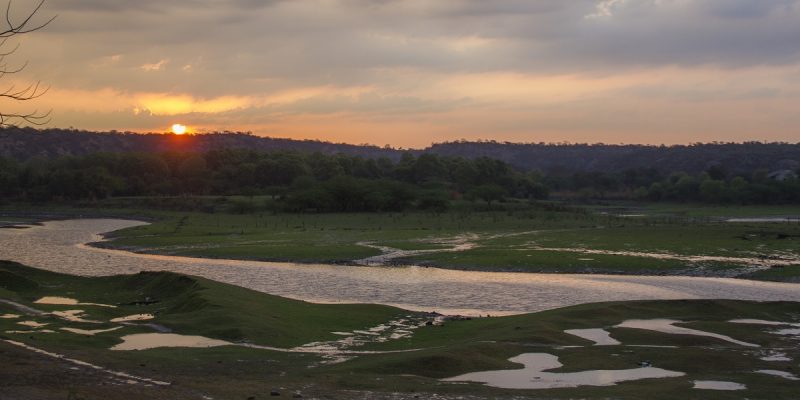The following is an adapted excerpt from Fractured Forest, Quartzite City: A History of Delhi and Its Ridge (SAGE Publications India and Yoda Press, 2020).
India’s capital city, Delhi, is, by some measures, the second-largest urban agglomeration in the world and is on track to be the biggest by 2030. The explosive growth has come at high ecological costs: Delhi frequently records the worst air pollution of any major city.
But Delhi is also surprisingly green, with an expansive network of small neighborhood parks and large protected forest areas. The latter are colloquially referred to as “the Ridge,” clustered around the hills of the Aravalli mountain range. Beginning in the 1980s and picking up steam in the 1990s – not coincidentally, the decade when neoliberalism hit India with full force – a strong environmental movement sprung up to “Save the Ridge” from new developments, including luxury malls planned by the country’s largest real estate developer. By 1996, the movement had scored some notable successes, including the official recognition of roughly thirty square miles of the Ridge as Reserved Forest, the most protected environmental category.

Thomas Crowley
Fractured Forest, Quartzite City: A History of Delhi and Its Ridge
Sage Publications (October 2020)
Behind these resounding successes, however, lay a more complex political landscape, as different actors deployed the language of environmentalism for divergent ends. Part of the “Save the Ridge” movement’s energy was harnessed by what the sociologist Amita Baviskar calls “bourgeois environmentalism,” dominated by “upper-class concerns around aesthetics, leisure, safety, and health.” This brand of environmentalism, coupled with the mainstream media’s focus on the Ridge as the “green lung” of the city, obscures crucial aspects of Delhi’s political economy, including those that depend on the Ridge’s underlying geology.
The stones of the Ridge have been important construction materials throughout Delhi’s millennium of urban history, but they took on special importance in the period after Indian independence, as the new nation’s capital city expanded at a frantic pace and real estate and construction activities boomed. By the 1990s, however, the neoliberal drive to make Delhi a “world-class city” had turned activities like quarrying and manufacturing into a perceived blight on the “clean and green” image Delhi was supposed to project.
These shifting attitudes reveal much about the making of a world-class megacity under the spell of neoliberalism.
Also Read: Book Review: The Ground Beneath Delhi’s Feet
The labour politics of quarrying
In the decades after independence, migrant workers in the quarrying industry were among Delhi’s most exploited workers. In the 1970s and early 1980s, quarry workers mounted increasingly ambitious attempts to unionise. Collective actions exploded, from workers’ cooperatives to lengthy strikes, at times supported by civil society organisations, at times relying on local leadership.
Workers not only had to confront contractors, quarry owners, and a growing set of middlemen, but also a paternalistic state that repeatedly affirmed its support for workers’ rights and dignity while quietly letting labour abuses go unchecked and striking backroom deals with contractors.
In 1983, a directive from the Delhi government blocked quarrying activity in the city, ostensibly for the workers’ sake. Frequent injuries and gruesome deaths had proved embarrassing for the government, which played an increasingly large role in the quarries’ management from the mid-1970s onward. After seven workers died in a pit-side collapse in 1990, a more wide-ranging ban was put in place in 1991.Yet this was cold comfort to the four thousand people who suddenly found themselves out of work. They must have been surprised to hear the state’s rhetoric of “worker’s safety.” After all, this was the same government that had overseen the quarrying industry and bore significant responsibility for its deplorable conditions. The workers protested that the mines should be reopened with stronger safety measures; the Delhi government found it easier to sweep the entire issue under the rug.
The quarries of Delhi were also offering diminishing returns, both geologically and financially, with crews forced to descend to groundwater levels, at which work is no longer feasible. Closing the quarries opened up other alluring possibilities for business interests.
Environmentalism as smoke screen
While some government officials were genuinely enthusiastic about environmental conservation – the largest of the quarrying sites was incorporated into a nearby wildlife sanctuary – the ecological justification for the closures served largely as a smoke screen, obscuring other motives. This became clear in the subsequent years, as ecologically harmful, non-native species were planted to maximise the appearance of a green cover in some parts of the wildlife sanctuary, while trucks carrying stones from illegal quarrying activities still plied its roads.
Worse, in other former mining areas, the land quickly developed into sites for much-coveted, high-end luxury estates, especially the misleadingly named, palatial “farmhouses.”The conversion of mines into luxury housing was no accident. As the activist Anita Soni notes, “It would be wrong to assume that the termination of quarrying has been the cause behind spectacular increase in the number of farmhouses and in the acreage of existing estates. In reality, the deals had been struck much in advance, during the years of the operation of the quarries.” Some former quarry workers found menial employment on the sprawling estates that proliferated.
The ban on mining thus appears as a kind of magic trick, disappearing quarries and replacing them with eco-friendly sanctuaries. And like any magic trick, it’s an illusion. Quarrying still goes on, because its products are essential to the ever-growing construction industry. It just happens outside of city limits. Actual quarrying work is messy: it involves real people doing real labour, oppressed by real exploitation and organizing real protests and real collective actions. Much better to cover this up and supplant it with a simulacrum of pristine nature.
This sleight of hand in the Delhi Ridge mirrors later developments in the Aravalli mountain range as a whole. In 2009, the Supreme Court banned mining in the entire range, citing ecological concerns. But the construction industry needs its raw materials, and Delhi keeps growing, meaning that mining will persist one way or another.
In the Supreme Court ruling, there was no mention of the people who actually work in the quarries and depend on them for their livelihood. Like the Delhi government, the Supreme Court has seemingly forgotten that these people exist. Their work, and their intimate relationship with the Aravalli stone, has been relegated to the shadows.

A file photo of the Supreme Court of India. Photo: PTI
“Be one with the rock”
These days, the stone of the Ridge is a breezy site for recreation. Instead of workers toiling in the quarries, there are climbers following the mantra “be one with the rock.” The stones are no longer a means of sustaining life, but rather a way for the relatively well-off to escape the drudgeries of urban existence.
This vision of the city – pushing aside the messiness of work (and working-class politics) in favour of scenic, tension-free sites of leisure – is hardly unique to Delhi. The artist and cultural critic Martha Rosler has spoken of the “Disneyland” model of the city, which swaps class conflict and other cultural, religious, social, and political tensions with a series of tranquil experiences.
The problem is that it does not actually solve the problems plaguing Delhi city – it just moves them to a less conspicuous location. The city’s population rises at an unsustainable pace, even as walls and cordons, both figurative and literal, keep green areas green, spacious areas spacious, poor areas poor, and polluted areas polluted. Mining persists, but on the sly, or simply further away.
The beneficiaries of these spatial rearrangements now enjoy a “vibrant” city of spotless parks, gleaming malls, mountain biking routes, and rock-climbing outings. But something is missing. An amusement park ride may be fun; but to live one’s days in an unending amusement park ride is, finally, nauseating. And there is a sense of unrest, a feeling that the walls and cordons will eventually break under so much pressure.
Also Read: The Forest Department’s Plan for One of the World’s Largest Urban Forests Is Baffling
Thankfully, this vision of the city is relatively recent and, if geology has taught us anything, it’s that everything changes, even those things that seem most permanent. Perhaps the geology metaphor can be pushed even further. Geologists speak of the Aravalli mountain range “suffering deformation” in the process of tectonic shifts. But this process eventually led to a grand mountain chain, one composed largely of metamorphic rock — something entirely new, though with traces of the old shot through it.
The city of Delhi has certainly seen its share of suffering and deterioration, along with a series of metamorphoses. If the Disneyland version of Delhi is a chimera, can something more promising rise in its place?
Thomas Crowley is a graduate student in geography at Rutgers University and author of the book Fractured Forest, Quartzite City: A History of Delhi and Its Ridge.




